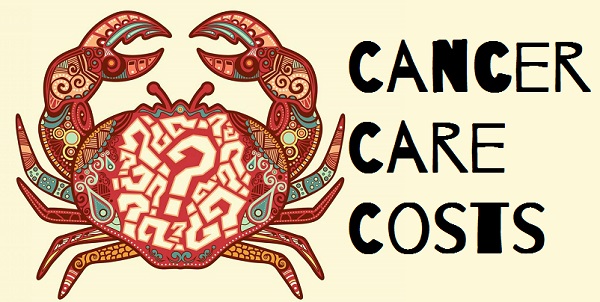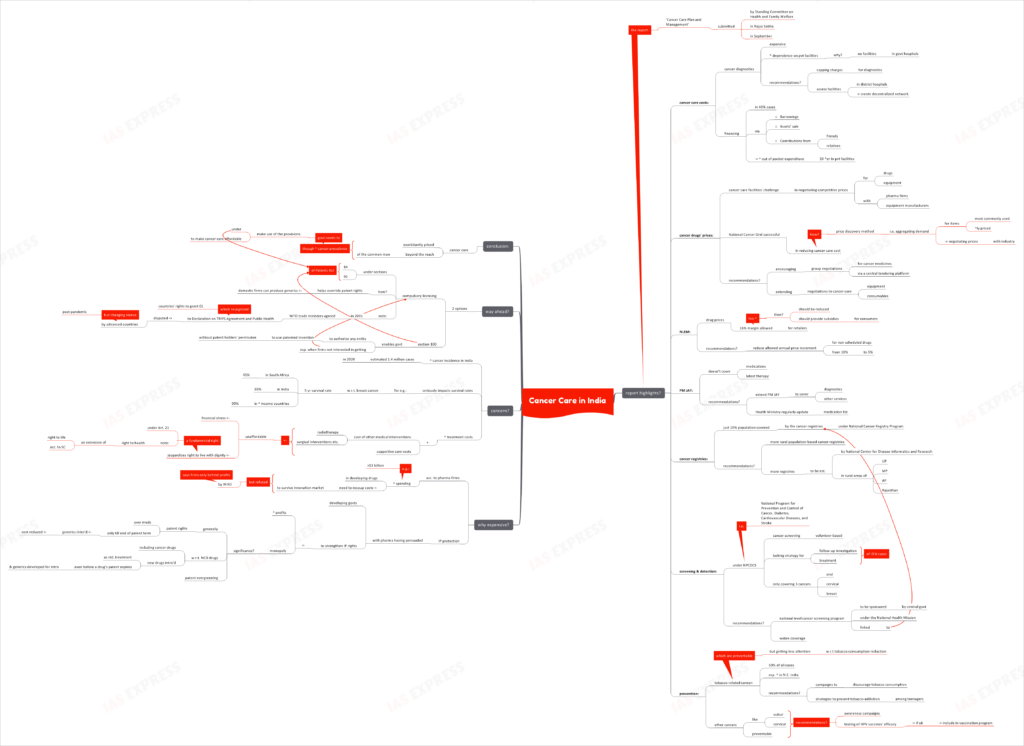Cancer Care in India- Making Cancer Drugs Affordable

Recently, a report ‘Cancer Care Plan and Management’ was tabled in the Rajya Sabha. A notable issue highlighted by the report is the spiralling cost of cancer drugs and their implications for the society.

This topic of “Cancer Care in India- Making Cancer Drugs Affordable” is important from the perspective of the UPSC IAS Examination, which falls under General Studies Portion.
What does the report say?
The ‘Cancer Care Plan and Management’ was submitted by the Standing Committee on Health and Family Welfare in September. Some of the key highlights are as follows:
On Cancer Care Costs:
- Cancer diagnostics are a costly affair and patients are dependent on private hospitals due to lack of facilities in government hospitals.
- The committee recommends capping the charges for such diagnostics.
- The Health Ministry can assess diagnostic facilities in district hospital and create a decentralized network of such facilities.
- The committee noted that 40% of the cancer-related hospitalizations are mainly financed through:
- Borrowings
- Assets’ sale
- Contributions from friends and relatives
- As a result, the out-of-pocket expenditure for cancer care is exorbitant. Cancer care is three times more expensive in private facilities, compared to public facilities.
On Cancer Drugs’ Prices:
- Cancer care facilities face a challenge in negotiating competitive prices with the pharmaceutical firms and equipment manufacturers, given the high prices of anti-cancer drugs and equipment.
- The National Cancer Grid has helped reduce cancer care cost, even while maintaining drugs’ quality, through its price discovery method, i.e., aggregating demand for the most commonly used but high-value items from cancer care centers and negotiating prices with industry.
- In addition to this, the committee recommends:
- Encouraging group negotiations for cancer medicines via a central tendering platform
- Extending negotiations to cancer care equipment and consumables
On NLEM:
- The cost of drugs listed in the National List of Essential Medicines/ NLEM are under the purview of the NPPA/ National Pharmaceutical Pricing Authority.
- The committee noted that the price of such drugs allows 16% margin for retailers- which is too high.
- The committee recommends reducing this margin or providing subsidies to the consumers.
- It also recommends a reduction in the allowed annual increment in non scheduled drugs’ prices- from 10% to 5%.
On PM-JAY:
- The committee recommends expanding the PM-JAY scheme to cover the diagnostics and other services under cancer care.
- Currently, the scheme doesn’t cover the medications and latest therapy that are available for cancer care. The committee recommends that the Health Ministry regularly update the medication list under the scheme.
On Cancer Registries:
- A mere 10% of the population is covered by the cancer registries under National Cancer Registry Program.
- There is a need for more rural population-based cancer registries to get a true picture of cancer prevalence in India. For this, the National Centre for Disease Informatics and Research can set up registries in rural areas of UP, MP, Rajasthan and Andhra Pradesh.
On Cancer Screening & Detection:
- Under the NPCDCS (National Programme for Prevention and Control of Cancer, Diabetes, Cardiovascular Diseases, and Stroke), cancer screening is volunteer-based and lacking strategy for follow-up investigation and treatment of identified cases.
- Central government should sponsor a national level cancer screening program, at the PHC level, under the National Health Mission.
- This screening program should be linked to cancer registries for better management.
- Currently, the NPCDCS covers only 3 cancers- oral, cervical and breast cancers. There is a need to widen its coverage.
On Cancer Prevention:
- 50% of all cancers in India linked to tobacco use.
- High incidence of tobacco-related cancers in the north-eastern states.
- Though such cancers are preventable, insufficient attention is being paid to cut down tobacco consumption.
- There is a need to undertake campaigns to discourage tobacco consumption and formulate strategies to prevent tobacco-addiction among teenagers.
- Other common cancers like vulvar and cervical cancers can be prevented via vaccination.
- The committee calls for awareness campaigns on cervical cancer symptoms.
- It also calls for testing of HPV vaccines’ efficacy in preventing cervical cancer. If it is shown to be satisfactory, this vaccine should be included in the immunization program.
Why are cancer drugs expensive?
- Large pharma firms argue that given the high spending that goes into the drugs’ development, there is a need to recoup the costs to survive the innovation market. For instance, more than $3 billion goes into bringing a single new molecule into market.
- However, this link between R&D spending and market prices has been refuted by the WHO. The health bodies holds that the pharma firms set the prices primarily to maximize profits.
- Intellectual property protection is another factor contributing to high costs. In the last 30 years, the sector has persuaded developing countries’ governments to strengthen IP rights, enabling them to reap hefty profits and establish monopolistic control over effective drug molecules.
- The scope of such monopolies is almost absolute due to several factors:
- Generally, patent rights over a medicine lasts only till the patent term remains valid. After the term expires, the generics are brought into the market, leading to a drop in medicine’s cost.
- However, in case of NCDs, like cancer, new therapies enter the market and get adopted as the standard for cancer treatment, even before a particular drug’s patent term expires and its generics are brought in.
- There is also the issue of patent evergeening which help pharmaceutical firms maintain their hold over the drug for extended periods.
Why is cancer treatment cost an issue?
- The high cancer care costs is a major issue considering the level of cancer incidence in India. In 2020, there were an estimated 1.4 million cases.
- High treatment costs seriously impacts survival rates, especially in developing countries.
- When it comes to breast cancer, the 5-year survival rate in India is 65% and in South Africa, it is 45%.
- At the same time, in high income countries, the survival rate is as high as 90%.
- When the cost of other medical interventions (like radiotherapy and surgical interventions) and supportive care are included, the overall costs would skyrocket.
- Hence, availing treatment for cancer often pushes the patients and their families into serious financial stress.
- Such high treatment costs jeopardize individuals’ right to live with dignity- a fundamental right under Article 21 of the Constitution. The apex court has interpreted right to health as an extension of the right to life.
What can be done?
- Compulsory licenses/ CLs are one option before the government in its quest to enable affordable cancer treatment.
- Granting CLs help override patent rights and enable domestic pharmaceutical manufacturers to churn out the generic versions of pricy patented drugs.
- Such licenses can be granted by the government in accordance with Sections 84 and 92 of the Patents Act.
- In 2001, the WTO countries’ trade ministers endorsed the Declaration on TRIPS Agreement and Public Health, recognizing every country’s right to grant such licenses.
- Understandably, this option faces opposition from the advanced countries. Fortunately, their stance has been changing in these past few years, following the outbreak of the pandemic.
- Another option is the Section 100 of the Patents Act.
- This section empowers the government to authorize any entity to use a patented invention without the patent holder’s permission.
- This option would be useful if the domestic firms don’t show an interest in getting CLs.
Conclusion:
Cancer treatment continues to be exorbitantly priced and hence beyond the reach of the common man in India as well as other developing countries. Given the significant prevalence of cancer, it is high time that the government make use of the provisions under the Patents Act to make cancer care affordable.
Practice Question for Mains:
Why is cancer care expensive in India? How can it be made affordable? (250 words)

